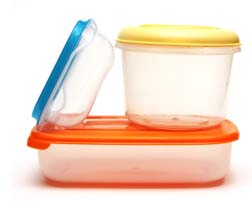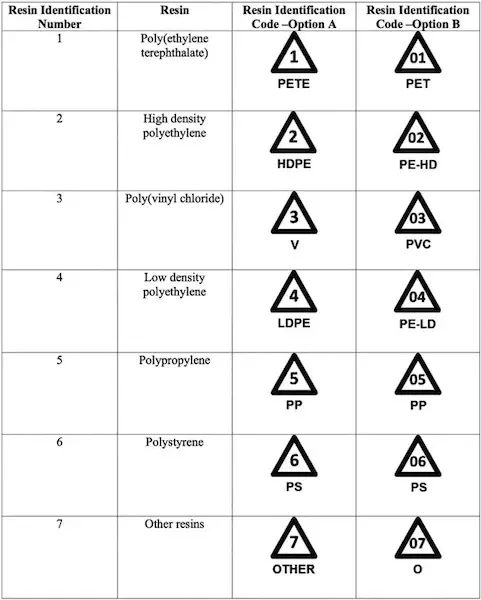Food Grade Plastic Guide: Keep Your Kitchen Safe & Healthy
- By Rebecca Taggart
- Reading Time: 6 mins.
 In our last blog about kitchen plastics, we discussed the health risks of chemicals like Bisphenol A (BPA) and phthalates in kitchen items. It’s clear we need to be careful when choosing our kitchen plastics—but how can you spot what’s safe?
In our last blog about kitchen plastics, we discussed the health risks of chemicals like Bisphenol A (BPA) and phthalates in kitchen items. It’s clear we need to be careful when choosing our kitchen plastics—but how can you spot what’s safe?
In this kitchen grade plastics guide, we’re giving you the information and tools you need to pick suitable food storage options. We’ll explain which plastics are the best to use and highlight a few brands that have committed to producing plastic products without BPA or phthalates.
Now, let’s dive into a quick refresher on BPA and phthalates, then go over how to pick eco-friendly food storage that will keep you and your family safe.
Risks of BPA and Phthalates
As we explained in our last kitchen plastics blog, chemicals like Bisphenol-A (BPA) and phthalates, found in many products, have raised alarms in recent years. They can seep into food and beverages, creating serious health risks.
BPA: Hormonal Disruptions and Health Implications
- BPA’s Role in Plastics Production: BPA is primarily used in polycarbonate plastics and epoxy resins. Its ability to mimic estrogen allows it to interact with hormone receptors in the body, potentially leading to hormonal imbalances and disruptions.
- Impact on Vulnerable Populations: The effects of BPA exposure are particularly concerning for infants and children. Their developing bodies and systems are more vulnerable to hormonal disruptions, and research has linked BPA exposure to significant developmental and behavioral consequences.
Phthalates: Flexibility at a Cost
- Usage and Exposure: Phthalates are added to PVC plastics to increase their flexibility. They’re common in various products, from food packaging to children’s toys. Like BPA, phthalates have been linked to multiple health issues, including reproductive abnormalities and an increased risk of asthma.
- Endocrine Disruption and Health Risks: These chemicals are notorious for their endocrine-disrupting capabilities. The risk is particularly acute for infants and children, as exposure during critical developmental periods can lead to lasting health issues.
The potential long-term health complications associated with exposure to BPA and phthalates underline the importance of choosing our plastics wisely. The more you know, the better you can protect yourself.
The Difference Between ‘Food-Safe’ and ‘Food Grade’ Materials
You’ve probably heard the terms “food-safe” and “food grade” used to refer to plastics before. Though they’re often used interchangeably, they actually mean very different things when it comes to your health.
- Food Grade Materials: This designation refers to materials approved for contact with food. Food grade plastics are deemed non-toxic and suitable for food interaction. However, just because a container is food grade does not mean it’s safe for all uses. For example, a food grade plastic container might be safe for storing dry pasta but could release harmful chemicals if it’s microwaved or used to store hot soup.
- Food-Safe Materials: A step beyond food grade, food-safe materials are not only safe for food contact but also pass stringent tests for temperature resilience and chemical leaching.
Understanding this distinction is crucial for ensuring that the materials we use in our kitchens do not compromise our health. Selecting food safe products, especially for high-heat applications, is paramount for safe and healthy cooking.
Identifying Kitchen Safe Plastics: Look for the Triangle

To choose safe options for storing your food, you need to understand the triangular plastic recycling codes embossed on plastic items. These codes, ranging from 1 to 7, not only facilitate recycling but also inform consumers like you about the type of plastic and its safety for food contact.
- Code 1 – Polyethylene Terephthalate (PET or PETE): PET is widely used for drink bottles, salad dressing bottles, and peanut butter containers. It is considered safe for single use but may harbor bacteria or leach chemicals after repeated use or exposure to heat.
- Code 2 – High-density Polyethylene (HDPE): HDPE is found in milk jugs, water bottles, and cereal box liners. You might also see its symbol on laundry detergent bottles. HDPE is known for its strength, durability, and safety in food contact, resisting moisture and chemicals.
- Code 3 – Polyvinyl chloride (PVC) – PVC is typically used in construction, medical devices, and credit cards, but you can also find it in cling film and other food packaging. PVC can release dangerous chemicals and often includes phthalates.
- Code 4 – Low-density Polyethylene (LDPE): LDPE is used for bread bags, squeeze bottles, and frozen food packaging. It’s flexible and considered safe for food contact, posing minimal risk of chemical leaching.
- Code 5 – Polypropylene (PP): PP has a high melting point, making it suitable for hot foods and liquids. It’s often used in microwavable plastics, syrup bottles, baby bottles, yogurt containers, and medicine bottles.
- Code 6 – Polystyrene (PS) – Often found in disposable cups, plates, and take-out containers, PS is lightweight and insulating. However, it can leach styrene, a potential carcinogen, especially when heated.
- Code 7 – Polycarbonate: No. 7 plastics are considered “Other” and include plastics made with BPA, a chemical that—as we mentioned above—has raised health concerns due to its estrogen-mimicking properties. While some polycarbonates are used in water bottles and food storage, consumers are increasingly seeking BPA-free alternatives.
Plastics with codes 1, 2, 4, and 5 are typically safe to use, while plastics with codes 3 , 6, and 7 can pose health risks. Choose No. 1, 2, 4, and 5 plastics whenever you can.
Recommendations for Safe Use
When it comes to using plastics in the kitchen, exercising caution can significantly reduce the risk of chemical leaching. That is particularly the case with items subjected to high temperatures. Microwaving plastics, even those deemed microwave-safe, can accelerate the breakdown of chemical bonds within the plastic. This breakdown can trigger the release of potentially harmful substances, like BPA and phthalates, into your food.
Similarly, the high heat of dishwashers can pose a risk of chemical leaching from plastics. Hand washing your plastic containers with warm, soapy water is a safer alternative. It will help your plastics last longer and minimize your exposure to chemicals.
Avoiding the microwave and opting for gentle hand washing can significantly reduce your likelihood of ingesting harmful chemicals. These simple, preventive measures will help protect your health without forcing you to sacrifice plastic in the kitchen completely.
Brands and Their Commitments to Safety
In the kitchen plastics industry, safety should come first. Some leading brands have now removed harmful chemicals from their products, showing a greater commitment to health and the environment.
For example, Glad has announced that its food storage containers and cling wraps are BPA and phthalate-free. This move is part of a broader industry shift towards more transparency and safety in food storage materials.
Likewise, SC Johnson states that its containers and cling film are free from BPA and dioxins. Tupperware has also joined this movement. Its American and Canadian product lines have been BPA-free since 2010.
While many brands have worked hard to improve product safety, it’s still vital for consumers like you to stay updated. Keep an eye out for new statements from brands and check the safety of new products, since formulations can always change.
Communicating with Food Companies About Safe Plastics
By engaging with food companies directly, you can help encourage them to use safer materials. Start by inquiring about the types of plastic they use in their products, requesting transparency regarding chemical compositions, and expressing your preference for BPA-free and non-phthalate options.
If you want to get even more involved, you can write to companies, participate in surveys, and use your social media platforms to tag brands and raise awareness. By voicing your concerns and demanding clarity, you’ll help move the industry towards greater transparency and safety in plastic use.
FAQ’s
Q1. What’s the difference between food grade and food-safe plastics?
Food grade plastics meet regulatory standards for food contact, while food-safe plastics ensure no harm or contamination under normal usage conditions.
Q2. How do I know if a plastic container is food grade or food-safe?
Check for a recycling symbol with a number inside (1, 2, 4, and 5 are generally safe) and look for labels like “food grade” or “BPA-free.”
Q3. Are chemicals like BPA and phthalates harmful, and if so, how do I avoid them?
Yes, BPA and phthalates can disrupt hormones. To keep yourself safe, choose “BPA-free” and “phthalate-free” products, and use plastics with recycling codes 1, 2, 4, or 5.


